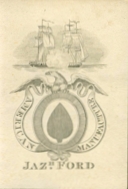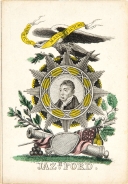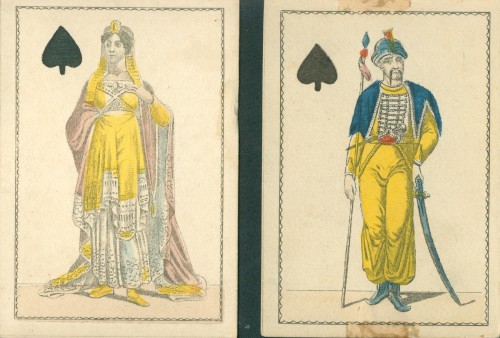
|
|
The Devil's Playing Cards — Made in Milton 1976 lecture by Charles R. Morris
What can playing cards tell us about the history of our country during the period of nationalism following the American Revolutionary War? Fortunately, the achievement of two Milton card manufacturers, the first in this country, according to historians of playing cards, to be designated as "card manufacturers," enables one to conclude that a great deal of history can be learned from packs of cards manufactured by two members of old Milton families, Thomas Crehore (1769-1846) and Jazaniah Ford (1757-1832). The use of playing cards in New England had not always been as widely accepted as it became in the eighteenth century, chiefly because of closer commercial and social ties with England where faro, whist, and piquet were played at the famous London gambling clubs, such as White's and Boodle's. Fortunes were lost at the tables, and the great Whig politician, Charles James Fox, whose name survives in Foxboro, Massachusetts, was a celebrated gambler of the period. During the seventeenth century, "The Devil's Picture Books" or the "Devil's Cards" were not approved by the stern Puritans and one of the earliest Massachusetts Bay statues (1631) decreed "that all persons whatsoever that have cards, dice, or tables in their houses shall make away with them before the next court under pain of punishment."
A strip of playing cards, reflecting "good copper plate work," says Eleanor Martin, made by Ford and Clark, links Jazaniah Ford, and other evidence, Thomas Crehore, to the Neponset River paper industrywhich had existed in Milton since 1728. The strip also tells us a great deal of history. Linked by marriage with the Clark family, pioneer paper makers of Milton, Jazaniah Ford, joined one of them in making of playing cards. Thomas Crehore, in the meantime, may have worked in Paper Maker James Boies's Mattapan Paper Mill, and is said to have lived in Mr. Boies's house on Curtis Road. The common design used in all five frames shown (above) on the strip has an eagle with a bunch of arrows in one hand and an olive branch in the other. This is the design of the Great Seal of the United States adopted in 1782, though, the strip, the Ace of Spades is superimposed upon the shield. But, study the stars: the first has fifteen, the second, sixteen, the third sixteen, the fourth fifteen, and the fifth thirteen. Added to the thirteen original states were Vermont, 1791, Kentucky, 1792, and Tennessee, 1796. Since the eagle strip, therefore, was made after 1796 and before the admission of Ohio in 1803, it is fair to assume that the "Clark" represented on the strip is the Milton paper making family since the family disposed of its interests in 1796. Since this is meant to be the story of card making in Milton I shall simply mention in passing that the story of paper-making is a fascinating story in itself. By 1845 the gross value of paper made in Milton reached $30,000, and of playing cards $15,000. Probably the Paper industry reached a peak of distinction in 1830, when Isaac Sanderson of Milton received a letter from President Andrew Jackson (owned by the Milton Historical Society) commending him for the quality of paper produced here. Without going into detail about the manufacture of playing cards, I shall mention only why the sheets of uncut cards and the packs of cut cards, in the possession of the Milton Historical Society, have survived 175 years in such good condition. They survived chiefly because paper was then made from rags. From before the American Revolution until years following it advertisements such as the following were frequently in Boston papers: "The Bell Cart will go through Boston before the end of next month to collect rags for the paper mill at Milton when all people that will encourage the Paper Manufacture may dispose of them." The Society owns some sheets of uncut cards still as firm and unstained as when they were first printed and colored, probably hand-colored by women of Milton. Though, like Jazaniah Ford a member of an old Milton family, Thomas Crehore did not make dramatic contributions, such as were made by Mr. Ford, to the history of playing card manufacturing. Yet there are interesting features of his career, and surviving Mr. Ford by fourteen years, with a family continuing to expand the business of card making in their River street, Dorchester, factory, he was most influential in the Lower Mills community, as was, of course, his brother, Benjamin, innovator in the manufacture of musical instruments. Let's start with two Thomas Crehore Milton tax bills: one for November 23, 1799, in pounds, shillings, and pence, and the other for December 4, 1802, in dollars and cents. Though the dollar exchange had been adopted by Congress somewhat earlier it was not until the turn of the century that the dollar replaced the English pound as the unit of exchange. This new pride in things American, and, particularly, "American Manufacture" is reflected in the scrolls printed on his cards. Being aware, though, that "made in Britain" still had its appeal, especially in New England of early nineteenth century, he may not have been above printing cards, one authority avers, in imitation of English export packs. One such card, owned by the Society, is marked "Henry Hart Exportation" (Hart was an English card maker). The card is topped with the crown, inscribed G111 Rex (for George III) with the motto of the Order of the Garter, Honi soit qui mal y pense, and Dieu et mon droit on the ribbon. Thomas Crehore in 1806 built his River Street factory on property acquired in 1801. With Milton paper manufacturers Thomas Crehore has close associations, and particularly with Amasa Fuller, one of whose estate executors he became. The Fuller Mill in Mattapan was a most successful paper mill absorbed by Tileston and Hollingsworth. The tax lists showed that Fuller was making paper as early as 1795. Thomas Crehore's cards appear to be cruder than Jazaniah Ford's, and his contributions to card making not as significant as Mr. Ford's, who is credited with introducing "Commemorative Cards" to the United States. The early nineteenth century marked the emergence of the United States as a confident, expanding world power, indeed "Manifest Destiny" became one of the popular slogans of the time, and the playing cards made by Jazaniah Ford (1757-1832) of Milton commemorated this new spirit. He was the first American card manufacturer of "Commemorative Cards" which celebrated this new spirit of the young nation. Two events: one, the defeat of the English Frigate, Macedonian, on October 12, 1812, by Captain Stephen Decatur in the United States, and the visits of General Lafayette to Boston in 1824 and 1825, were chosen by Mr. Ford to commemorate, and the packs of cards he made are now much-prized museum pieces both in this country and in Europe. Related to three important Milton families, the Sumners, Clarks, and Tuckers, Mr. Ford eventually settled on Highland Street, near what is now Spafford Road to make his home and to manufacture cards. The house and barn are no longer in existence. Cards made there sold in Washington, Philadelphia, Baltimore, New Orleans, Kentucky, Mobile, New York and numerous other places. Later his cards found their way into private collections of Henry Ford, Florenz Ziegfeld, and others; and into public collections such as the museum of the United States Playing Card Company in Cincinnati and the British Museum in London. In 1936 when the film, "The Gorgeous Hussy" was made, with Lionel Barrymore and Joan Crawford in starring roles, Ford cards were obtained from the Milton Historical Society to be used in the tavern scenes. Indeed, it is not too much to say that Ford cards, made in respectable old Milton, Massachusetts, may have been used by Ohio and Mississippi River gamblers, and when that derringer is whipped out in some tense scene of the movies, it may have been because someone tampered with a Jazaniah Ford Commemorative Pack! Mr. Ford served in the Revolutionary War and was present at the surrender of Burgoyne at Saratoga, but when the War of 1812 came, he was too old to serve, and so he became active as first lieutenant in a militia company called "Exempts", of which General Joseph Vose, whose home still stands on Voses Lane, was captain. The Power House recently preserved and now located across from the town office building was built to store powder for the use of the militia, founded, in part, to provide costal defense in case of the opening of hostilities against England.
Such a man, as might be expected, has strong feelings of patriotism, and when the brilliant Commodore Stephen Decatur emerged as a national hero following his victories, and when the much-loved and venerated General Lafayette visited New England, Mr. Ford must not only commemorate the occasions, but, he must also heighten their achievements, and also provide a glimpse of our national destiny, by placing the United States in rank with the great empires of history, Greek, Roman, Frankish and Oriental. What resulted were his much admired packs of costume cards used first when the Decatur pack was issued in 1815, and reissued when the Lafayette pack appeared in 1824 and 1825. Briefly, the suit of hearts stood for the Roman Empire; diamonds, probably the Greek; clubs, probably the Frankish (Lafayette's visit kept alive the American feeling of indebtedness to the Frenchfor their help in the Revolution), and spades, the great Oriental empires, Byzantine, Saracenic, Turkish, Persian, etc. The Classic emphasis also appealed to a culture deeply steeped in the study of the classics, as reflected in its architecture, place names, and education. The eagle, traditionally the symbol of empire and military strength, was adopted in 1782 to be used on the Federal seal over the protest of Benjamin Franklin who opted for something more characteristically American such as the wild turkey or pigeon. The Decatur pack was issued in 1815, a few months after the composition of the Star Spangled Banner at Fort McHenry in Baltimore on September 13, 1814. The scene on the pack might have been one of three brilliant achievements of Commodore Decatur: action against the pirates in Tripoli in 1804; the defeat of the English frigate, Macedonian, in1812; or action against Algeria in 1815. It is probable that the scene portrayed is the defeat of the Macedonian in 1812. The card pictures a spade enclosed in a circle, surmounted by an eagle, with "American Manufacture" inscribed in encircling ribbons, and Jazh Ford at the bottom. At the top is a battle scene between two frigates, presumably, the United States and the Macedonian. When decorated, as in the book, America's Arts and Skills, the card is beautiful indeed, and deserving to be classified as a "Rare, Historic Playing Card." General Layafette's visits to Boston, in 1824 and 1825, occasioned tremendous enthusiasm. Everyone shared in the welcome to this much-loved man. On the appointed day, his coach, drawn by four white horses, proceeded from Roxbury where he had spent the night with Governor Eustis, and, escorted by the Boston Light Infantry and a cavalcade of 1200 horsemen, he drew a welcome from spectators at every door, window, and porch. As the poet said, "We bow not the neck Milton was not immune to Boston's enthusiasm. When Lafayette drove to Braintree to visit the aged John Adams — he and Thomas Jefferson were to die in 1826, the fiftieth anniversary of the Declaration of Independence — his carriage stopped at Doctor Amos Holbrook's house on Adams Street. Jazaniah Ford and wife, according to Sumner family records, took their four-year old granddaughter to the Quincy church to see Lafayette. What a memory for her to carry through life! Mr. Ford's Lafayette card shows a portrait of Lafayette in a circle from which a sunburst radiates. At the base is crossed cannons, the American flag, the ace of spades, and the signature, "Jazh Ford." At the top is an eagle with a ribbon clutched in its beak inscribed "American Manufacture." It is beautifully decorated in yellow and red and green. When M. B. Cary, Jr. published his book War Cards in 1937, he used the Ford Lafayette design for his frontispiece, with "w.w." for his press, the "Woolly Whale," replacing the picture of Lafayette. Ford's Lafayette cards, like his Decatur cards, are reproduced in virtually all recent books on the history of playing cards, such as Catherine Hargraves A History of Playing Cards. The English historian, Roger Tilley in A History of Playing Cards gives full recognition to Jazaniah Ford for his achievement. For this recognition, and all other recognition, the late Eleanor Martin of Milton must be given full credit, for it was she who made the Milton Historical Society collection widely known and did the primary research to authenticate the achievements of Thomas Crehore and Jazaniah Ford. NOTE: The Milton Historical Society has a large collection of playing cards produced by Ford, the first American to manufacture commemorative playing cards and the first American to produce distinctively designed court cards, dressing his jacks and queens in the costumes of foreign countries. |




